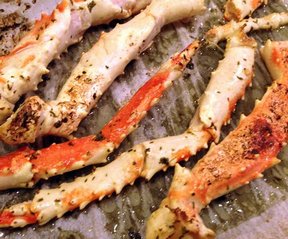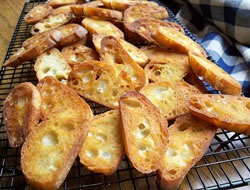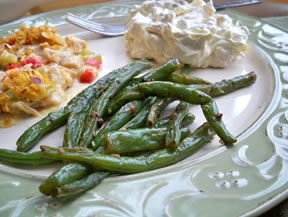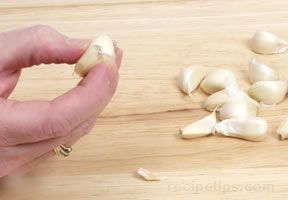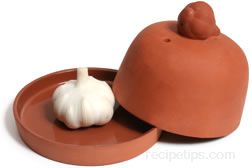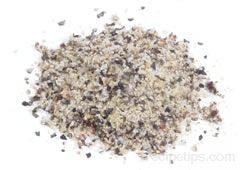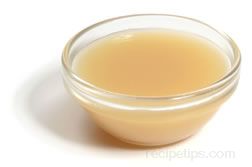Similar Content to: Garlic Press
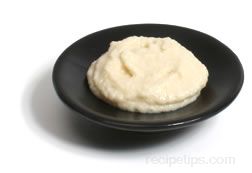
Green garlic, is one type of garlic that is the early stage of growth before the cloves begin to form. Similar to a fresh green onion or leek that is not fully matured, Green galic has a green leafed shoot attached to a very small white bulb. When purchased, green garlic is much milder than mature garlic and is often used as a flavoring for salads and mildly flavored garlic seasonings.
As the garlic matures, the bulb enlarges into cloves and the harvested bulb is the form most often found in food stores as fresh garlic, being either a hardneck or softneck variety. With over 300 different varieties of garlic being grown, the most common are the white-skinned American garlic or the purplish pink-skinned Italian and Mexican garlic. Elephant garlic is a type of garlic that is actually closer to the leek family than the garlic family, but still considered a garlic and is a variety that is fairly common. The strongest flavored of the four garlic types is the American garlic while the other varieties are milder in flavor, with the Elephant being the most mild. Typically, the common garlic bulbs can yield 12 to 16 small cloves or if the variety is the larger Elephant garlic, it will yield 6 to 8 large cloves that are 2 to 3 times larger than the smaller cloves of the common garlic. Elephant garlic, is also referred to as Giant or Spanish garlic.
In addition to fresh, dried garlic is another form of garlic, one which has been dehydrated and sliced into flakes or instant garlic, which are minced bits, both of which are often used in sauces, soups, stews and other liquid dishes that allow the garlic to become reconstituted. Other forms of garlic include powder, garlic extract, garlic paste, garlic juice, and garlic salt.
For storage, keep whole bulbs of garlic in a cool, dry, dark area where they can be stored for several months. Garlic containers with lids are available which are made of various materials such as pottery that keep the garlic dry and out of sunlight. When the cloves have been removed from the bulb, they can be kept from 3 to 10 days, but if frozen they can be kept for several months. To freeze whole unpeeled garlic or chopped and crushed garlic, place it in an airtight container to be stored in the freezer. When it is to be prepared, remove the garlic from the freezer and detatch whole cloves or grate the amount needed while frozen. If the garlic was crushed and frozen, simply break off the desired amount for use. Another method of preparing garlic for freezing is to puree the garlic prior to freezing in a food blender, small food grinder or processor using 1 part garlic and 2 parts oil. Upon completion of the puree, store the contents for freezing and then when ready to use, break off pieces as desired. Garlic that has sprouted is still usable if the cloves are still crisp. However, do not store raw garlic at room temperature if it has been moistened or placed in oil. The garlic can easily develop bacteria that may result in food poisioning from botulism.
A tip for removing the garlic odor from hands when working with garlic is to wash hands thoroughly and then use some type of stainless steel device as a rubbing board that can be worked over and around the ares affected on fingers or hands. Stainless steel contains the mineral nickel which acts as a neutralizer for the garlic odor. Several manufacturers provide a kitchen utensil, similar to a flat bar of soap made of stainless steel, that can be rubbed over the hands after coming in contact with garlic. Other options include using a faucet or stainless steel sink surface to rub hands on after first washing the exposed areas.
Garlic Yeild: (The figures below are estimated amounts and sizes, which will vary according to your own estimation of the size of the clove.)
An extra large clove of garlic will be approximately 1 3/8 to 1 1/2 inches long with a diameter of 3/4 to 7/8 inch at the widest point and produces approximately 2 tsp. of minced garlic.
A large clove of garlic will be approximately 1 1/4 to 1 3/8 inches long with a diameter of 5/8 to 3/4 inch at the widest point and produces approximately 1 1/2 tsp. of minced garlic.
A medium clove of garlic will be approximately 1 1/8 to 1 1/4 inches long with a diameter of 1/2 to 5/8 inch at the widest point and produces approximately 1 tsp. of minced garlic.
A small clove of garlic will be approximately 1 to 1 1/8 inches long with a diameter of 3/8 to 1/2 inch at the widest point and produce approximately 1/2 tsp. of minced garlic.




